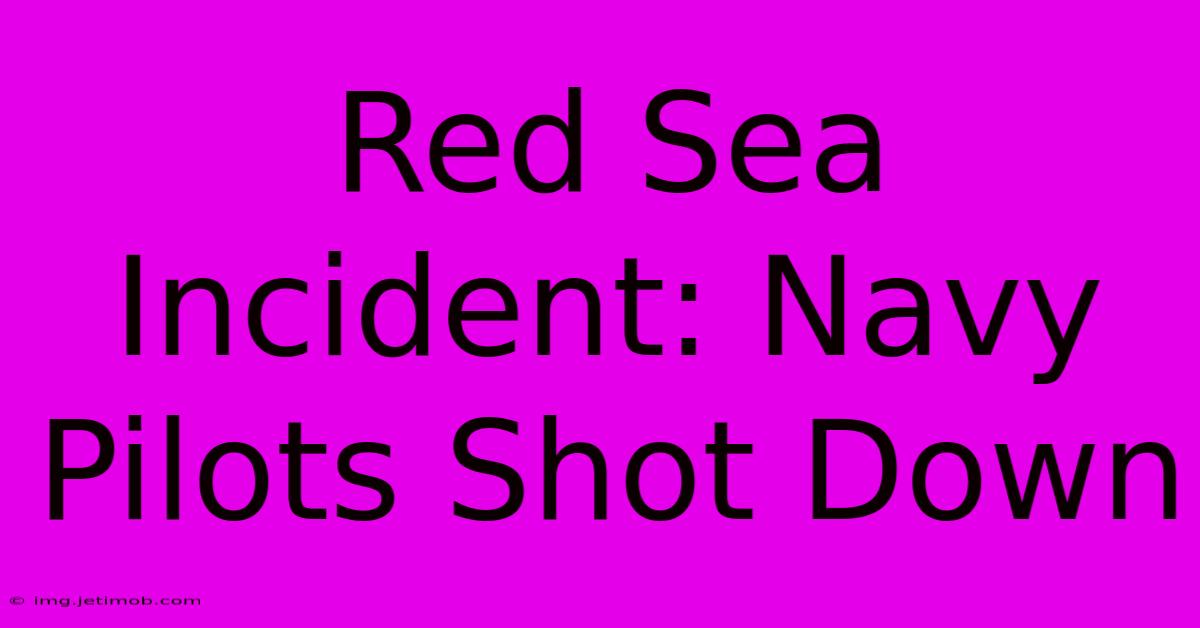Red Sea Incident: Navy Pilots Shot Down

Discover more detailed and exciting information on our website. Click the link below to start your adventure: Visit Best Website. Don't miss out!
Table of Contents
Red Sea Incident: Navy Pilots Shot Down – A Deep Dive into a Mysterious Event
The Red Sea, a narrow waterway connecting the Indian Ocean to the Mediterranean, has witnessed its fair share of historical drama. Beyond the bustling shipping lanes and vibrant coral reefs lies a darker chapter, marked by mystery and unanswered questions: the alleged shooting down of US Navy pilots over the Red Sea. While no single definitive incident universally bears this title, several events involving US Navy aircraft and hostile fire in the Red Sea region warrant examination, highlighting the inherent risks of naval operations in volatile geopolitical areas. This article delves into these potential incidents, exploring the available information and the persistent ambiguities that shroud them.
The Challenges of Defining "The" Red Sea Incident:
It's crucial to establish upfront that there isn't one singular, universally acknowledged "Red Sea Incident" where US Navy pilots were definitively shot down. Instead, the term broadly refers to a series of potentially related incidents involving near misses, hostile actions, and possibly downed aircraft, all occurring within the Red Sea and its surrounding regions over different periods. Pinpointing a specific event proves difficult due to:
- Classified Information: Much of the information surrounding military operations, especially those involving potential losses or hostile engagements, remains classified. This naturally limits the public's access to a complete picture.
- Conflicting Accounts: Differing narratives from participants, witnesses, and official statements often emerge, making it challenging to construct a cohesive and accurate account.
- Attribution Difficulties: Determining the precise origin of hostile fire, whether from state actors, non-state actors, or even accidental occurrences, can be exceptionally complex.
Possible Incidents and Contributing Factors:
Several events involving US Navy aircraft in the Red Sea region contribute to the broader narrative of "Red Sea Incidents." These incidents often share common threads:
- Regional Instability: The Red Sea region has historically experienced periods of significant instability, marked by armed conflicts, proxy wars, and the presence of various militant groups. These factors increase the likelihood of unintended or intentional confrontations with military aircraft.
- Tensions with Opposing Forces: Depending on the specific timeframe, US Navy operations in the region may have brought them into close proximity with forces hostile to US interests, leading to increased risk of conflict.
- Technological Limitations: The capabilities of air defense systems have evolved significantly over time. Older incidents might lack the clear evidence (e.g., radar data, recovered wreckage) that modern investigations would readily provide.
- Misidentification: Friendly fire or mistaken identity is always a possibility in complex military operations. Aircraft might be misidentified as hostile targets, leading to unintended engagements.
Analyzing the Narrative: While specifics remain limited due to classification, analyzing the common themes reveals potential scenarios:
- Accidental Engagements: Mistaken identity or unintentional encounters with air defense systems could lead to downed aircraft. These accidents might be downplayed or shrouded in secrecy to avoid diplomatic repercussions or damage to national security.
- Targeted Attacks: Deliberate attacks on US Navy aircraft are another possibility. Such actions might be attributed to state-sponsored actors, militant groups, or even rogue elements within regional forces. The motivation behind these attacks could range from political statements to territorial disputes.
- Mechanical Failures: Finally, the possibility of mechanical failure or other technical issues contributing to aircraft loss cannot be ruled out. While less sensational, these possibilities still highlight the inherent risks of naval aviation.
The Importance of Transparency and Investigation:
The lack of comprehensive public information regarding any alleged shooting down of US Navy pilots in the Red Sea underscores the importance of transparency in military operations. Open and thorough investigations, while respecting the need for security classification, are crucial to establish accurate accounts, prevent future incidents, and ensure accountability. Without such efforts, the narrative surrounding "Red Sea Incidents" remains shrouded in speculation, hindering a full understanding of these complex events.
Conclusion: Unraveling the Mystery:
The search for definitive answers surrounding any alleged "Red Sea Incident" remains an ongoing challenge. The confluence of classified information, conflicting accounts, and the inherent complexities of military operations in volatile regions makes a definitive conclusion difficult. However, by analyzing the available information, exploring the regional context, and emphasizing the need for transparency, we can shed light on these mysterious events, learning valuable lessons about risk management, international relations, and the importance of accountability in military aviation. Further research and the eventual declassification of relevant documents may one day bring a clearer understanding of the potential incidents and their true nature. Until then, the Red Sea’s depths continue to hold their secrets, leaving this chapter of naval history marked by both intrigue and uncertainty.

Thank you for visiting our website wich cover about Red Sea Incident: Navy Pilots Shot Down. We hope the information provided has been useful to you. Feel free to contact us if you have any questions or need further assistance. See you next time and dont miss to bookmark.
Also read the following articles
| Article Title | Date |
|---|---|
| Real Madrid Vs Sevilla 2024 Live Stream | Dec 23, 2024 |
| Mahomes Mayhem Chiefs Record Ravens Victory | Dec 23, 2024 |
| Friendly Fire Kills Two Navy Pilots Red Sea | Dec 23, 2024 |
| 6 3 Victory Liverpool Vs Tottenham Analysis | Dec 23, 2024 |
| Liverpool Thrash Tottenham 3 6 Epl Report | Dec 23, 2024 |
| Hurts Concussion Out Against Commanders | Dec 23, 2024 |
| Death In Paradise New Cast Member Review | Dec 23, 2024 |
| Apparent Friendly Fire Kills Navy Pilots | Dec 23, 2024 |
| Nfl Losses Dolphins 49ers Eye Redemption | Dec 23, 2024 |
| Jets Rams Recap Fast Start Scoring Drought | Dec 23, 2024 |
